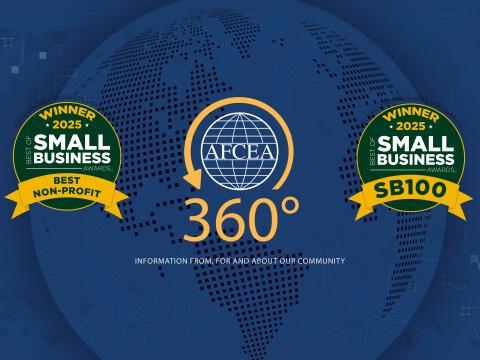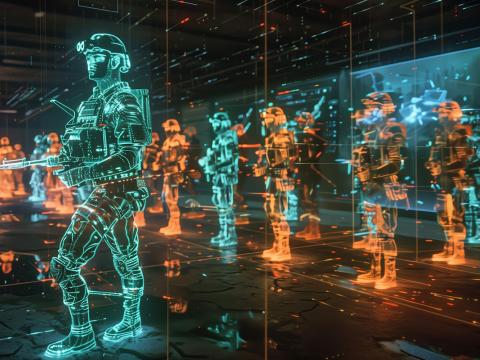Navy Pursues a Better Attack Submarine Virtually
Technical advances in the field of virtual reality, also known as virtual worlds (VWs), are making it possible for the U.S Navy to tap into the collective expertise of its best submariners to design and build the next generation of attack submarines.
At the Naval Undersea Warfare Center (NUWC) in Newport, Rhode Island, designers are able to create collaborative environments for submarine development using a fully immersive virtual reality application similar to the popular Second Life environment, which enables them to interact with one another both audibly and visually. Numerous participants at remote sites worldwide are linked to one another through the Defense Department’s secure computer network.
Steven Aguiar is virtual worlds program manager at the NUWC Newport Division and oversees much of the current program work involving VWs and the design of command and control (C2) facilities on submarines.
“Since 2008,” he explains, “my command has identified virtual world technologies as having the potential to radically change a number of aspects of many business areas” related to the missions of NUWC. One of those ways, he goes on, is in how experts in various areas of warship design collaborate when they are not working together in person.
Aguiar says the virtual worlds applications that support almost all of the NUWC’s work are commercial off-the-shelf software. He says those applications range from training to acquisition support, modeling and simulation, and visualization.
For the submarine C2 design work, Aguiar says the NUWC uses an open-source application known as Open Simulator, which provides a virtual environment similar to that found in Second Life as a development platform.
“We’ve been applying it through a number of program sponsors to look at the next generation of submarine attack centers for multiple classes of ships,” he explains.
As a result of these projects, Aguiar says his group has assembled what he calls a “collaborative group of engineering strings,” which represent a variety of capabilities, including the appearance of the C2 centers, how they are manned and what kind of applications are used. He adds they can even test for the expected performance of any or all of those C2 centers elements using experienced submarine crewmembers who help test various C2 designs.
Aguiar says the use of virtual worlds technology for collaboration makes possible a rapid design and prototyping process in the development of attack submarine C2 centers. The process developed at the NUWC brings together fleet sailors, program officers, scientists and analysts—all the different communities involved in different ways in the design of attack submarines.
In one case, says Aguiar, a VW is used to analyze existing submarine C2 centers to better understand the relationship between crewmembers and the computer-based equipment with which they operate the sub and conduct military operations.
“Beyond looking at the models,” he explains, “we have the ability to play prerecorded at-sea data recorded on board a live submarine or a high-fidelity trainer and play it back into the virtual space.” The playback allows analysts and designers to “expose how information flows in a command and control space, both in the electronic and sensor realm, but more importantly into the human realm.”
Aguiar says the most powerful application of virtual worlds in submarine development is the ability to do rapid prototyping of proposed designs for future submarine classes that emerge from the analysis process.
He explains that while traditional computer-aided design programs can create detailed, high-fidelity virtual models, the programs can usually only render so-called wireframe outline illustrations. They also can take hours to create models using even the most powerful supercomputers available. By comparison, Aguiar says that most virtual world applications are able to create models in real-time, “and what that means is that the virtual world itself provides a building palette that lets one or more designers walk into that space and build the world around them with as much or as little fidelity as they need.
“We’ve used that capability when we’ve brought in sailors from the fleet,” he explains, “and subject-matter experts into a conference room setting provided them with an open sim developer, and in real-time they describe the future attack center they need to meet their future requirements. As they describe it, the renderer develops it.”
As a result, Aguiar says, his team now has “about two dozen future attack centers that had been created in that way, and every single one of them was built in less than one hour.”
“It very powerfully supports that rapid prototyping function, and really unleashes innovation,” he adds.
Because the process is virtual and real-time, all participants get the, “instant gratification and instant feedback” that comes from immediately seeing the result of their idea. Additional changes can be made almost immediately.
“The models we create are persistent,” he goes on to explain. “We bring them back into our laboratories, researchers can play back data into the models and we now have the power to understand those new spaces.”
The next step, says Aguiar, is to improve upon the development capability of virtual world design.
“Ultimately, you want to get your warfighter into these future spaces, have them actually conduct missions and measure their performance.” At present, he continues, that level of prototype testing takes place in a physical mock-up, known as a concept-of-operation exercise.
In the future, however, he suggests that once the virtual C2 center is created, it may be possible for the screens to be connected to a live tactical system, operating the same software applications running on today’s submarines. Sailors would be able to test new configurations using the same mission applications they use daily and determine whether they improve a submarine’s ability to complete its mission.
Aguiar is expected to present the latest developments in the use of virtual worlds technologies for submarine design at the NUWC during the 5th Annual Federal Consortium for Virtual Worlds Conference, scheduled to take place May 16th through the 18th on the campus of the National Defense University in Washington, D.C.




Comments